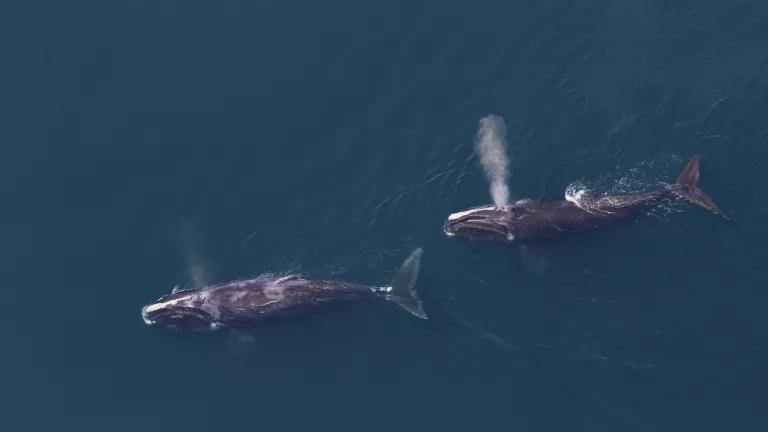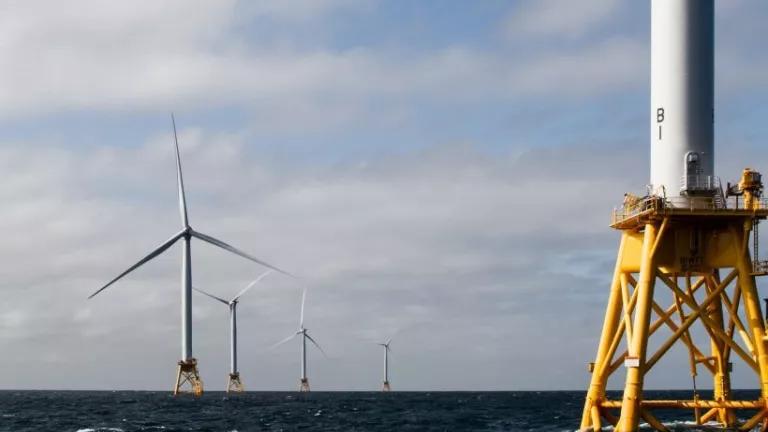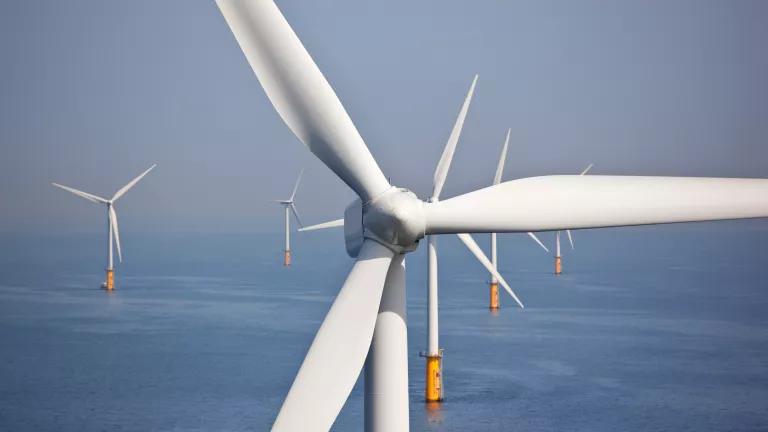
Chad Sawyer
The U.S. Atlantic’s blue economy is busier than ever before: a chain of offshore wind leases is under development, growth of marine shellfish and finfish farming is anticipated, and the Panama Canal expansion, opened in 2016, has increased East Coast trade and traffic from massive ships. Our ocean is also home to a wide variety of wildlife, from critically endangered North Atlantic right whales and sea turtles to dolphins and fish. It’s imperative that we coordinate existing and new ocean uses to drive responsible growth that supports our wildlife, families, and businesses for generations to come.
Dozens of state and federal agencies with overlapping and sometimes conflicting responsibilities make decisions about offshore businesses. The agencies don’t always collaborate upfront with each other, or stakeholders, and that can create confusion and controversy. But this is changing.
“The whole point … is for every entity at the table to work together to maintain a healthy ocean ecosystem, sustainable ocean uses, because we found that … the work being done in a vacuum just isn’t going to get it done for these pressing challenges of the 21st century.”
– John T. Kennedy, Mid-Atlantic Gateway Director, U.S. Department of Transportation
One year ago this week, the Mid-Atlantic and Northeast regions, together with their federal agency partners and Native American tribes, committed to enhance ocean coordination by signing on to regional roadmaps that help ensure the waters off our shores remain healthy and serve as economic engines for the long haul. These first-ever regional ocean plans—the Northeast Ocean Plan and the Mid-Atlantic Regional Ocean Action Plan—set out best practices for state and federal agency collaboration on key issues, like sand mining to rebuild our beaches and ways to enhance ocean recreation. By using the best available data and calling for early stakeholder engagement, these plans for good governance will allow managers and industry leaders to make better informed and quicker development decisions.
The regional plans are only a year old, but we’re already seeing benefits. The plans are helping:
- Bring stakeholders to the table early to discuss offshore wind. The offshore wind industry is poised for tremendous growth within an already crowded ocean economy. Encouraged by the regional ocean planning effort, BOEM has taken steps to increase public involvement, recently publishing A Citizen’s Guide about their offshore renewable energy process and how to engage in project proposals. And, in response to concerns about the potential impact of offshore wind development on existing fisheries, BOEM contracted with the National Academies of Science to launch the Atlantic Offshore Renewable Energy Development and Fisheries Steering Committee to hear from fisheries scientists, fishery managers, and fishermen directly about how best to identify, monitor, and mitigate the impact of offshore wind energy activities on fishing communities and fish populations.
- Advance smart siting of aquaculture, sand mining, and other uses. To support the plans’ development, each region collected a massive amount of state, federal, and stakeholder data on ocean use and marine life and centralized the information on easy-to-use websites: the Northeast and Mid-Atlantic ocean data portals. Open to all, the portals are a shared starting point for project discussions and have become go-to libraries for better understanding the offshore environment. The portals are also helping to make agency decisions more transparent, and helping shape sensible proposals. For example:
- New Jersey recreational fishermen recently used portal data to share with federal regulators their concerns about a potential sand mining project at Manasquan Ridge, a key fishing ground for summer flounder and bluefish. Parties are now discussing alternatives.
- Even before the plans were final, the Northeastern Massachusetts Aquaculture Center at Salem State University used portal data to advise development of the first shellfish farm in Atlantic Ocean federal waters, which was permitted in 2015. The application used portal data to show the 33-acre farm with longlines for blue mussels to grow would not negatively impact whales, shipping traffic, or existing fishing activity.
- Identify areas important for ocean wildlife and monitor health. Healthy oceans are a crucial source of food, jobs, and recreation; the linchpin of a prosperous blue economy and a key component of the quality of life for millions of people who live along and visit the Atlantic shoreline. In the Mid-Atlantic and Northeast, state and federal leaders are working closely with scientists and stakeholders to identify offshore areas which contribute significantly to overall ecosystem health by hosting a high diversity and/or abundance of wildlife or that are especially unique or sensitive. This information provides all of us, from state to federal managers, businesses to environmental planners, a guide to places that warrant particularly careful consideration in siting decisions and which may be of major importance for stressed wildlife in the face of climate change induced stresses like warming waters, which are shifting fish stocks northward, and ocean acidification that makes it harder for shellfish to grow their protective coverings and survive. Additionally:
- Both regions are developing a suite of ocean health indicators, like water quality, that help convey where ocean health is improving and where additional attention may be needed.
- The Mid-Atlantic Coastal Acidification Network (MACAN) has formed to serve as an information hub for ocean acidification research, industry, and resource managers, and to support collaboration to address coastal and ocean acidification.
- Identify ocean recreation hotspots. The Mid-Atlantic just finished a series of workshops to discuss with communities how and where they like to use the ocean for fun: surfing, kayaking, paddleboarding, boating, etc. Knowing more about how people are enjoying the ocean allows for better project siting and an understanding of where impacts between users could occur.
“Ocean planning is a way to protect the areas that you fish … it’s a way of continuing the tradition that is fishing. We are getting to a boiling point where all these different ocean uses are coming to a head and we will have real access issues … This is a public resource we are talking about, and all stakeholders, all interests need to have input into that process. We need to be heard, we need to engage, and ocean planning is providing us that opportunity.”
– John McMurray, Owner/Operator, OneMoreCast
There’s a lot happening offshore—and the regional plans are helping inform our decisions about this shared public space. With one year down, we’re making great strides to support sustainable economic development, help understand and conserve ocean health, and balance multiple ocean interests. Everyone has a stake in our ocean and its future, and these plans will continue to ensure we all have a voice in decision-making, right from the start.





